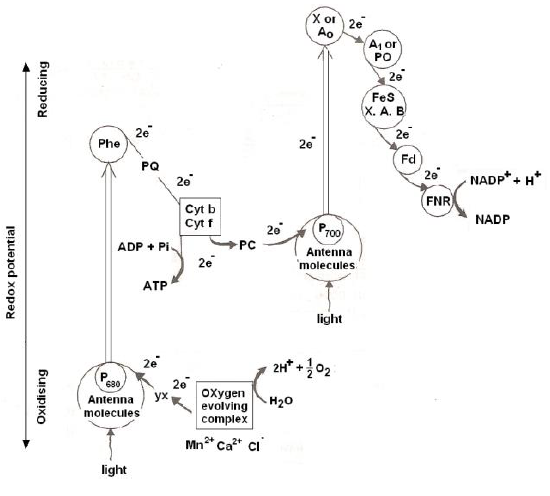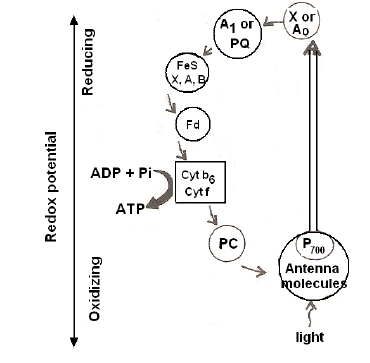PHOTOSYSTEM II (PS II)
• It is a photosynthetic pigment system alongwith some electron carriers that is located in the appressed part of grana thylakoids.
• PS –II has chlorophyll a,b and carotenoids.
• Chl a and Chl b contents are equal.
• Carotenoid content is higher as compared to that of PS I
• The photocentre is a special chlorophyll a molecule called P680
• It is surrounded by other chlorophyll a molecules, chlorophyll b and carotenoid molecules
• PS II also contains Mn2+, Cl-, quencher molecules Q, plastoquinon (PQ), cytochrome complex and plastocyanin.
• It picks up electron released during photolysis of water.
• The same is extruded on absorption of light energy.
• As the extruded electron passes over cytochrome complex, sufficient energy is released to take part in the synthesis of ATP from ADP and inorganic phosphate.
• This photophosphorylation is non-cyclic.
• PS II can operate only in conjugation with PS I
NON – CYCLIC PHOTOPHOSPHORYLATION
• It is the normal process of photophosphorylation in which the electron expelled by the excited photocentre does not return to it.
• Non-cyclic photophosphorylation is carried out in collaboration of both photosystem I and II.
• Electron released during photolysis of water is picked up by photocentre of PS II called P680.
• The same is extruded out when the photocetre absorbs light energy.
• The extruded electron has an energy equivalent to 23 kCl / mole
• It passes through a series of electron carriers phaeophytin, PQ. Cytochrome b6 – f complex and plastocyanin.
• While passing over cytochrome complex, the electron loses sufficient energy for the synthesis of ATP.
• The electron is handed over to photocentre P700 of PS I by plastocyanin. P700 extrudes the electron after absorbing light energy. The extruded electron passes through special chlorophyll P680 molecules, Fe-S, ferrodix, to finally reach NADP+
• The latter then combines with H+ with the help of NADP – reductase to form NADPH.
• This is called Z scheme due to its characteristics zig-zag shaped based on redox potential of different electron carriers.
• Non-cyclic photophosphorylation or Z-scheme is inhibited by CMU and DCMU.
• DCMU ( Dichlorophenyldimethyl urea) is a herbicide which kills the weed by inhibiting CO2 fixation as it is strong inhibitor of PS II

CYCLIC PHOTOPHOSHORYLATION
• It is a process of photophosphorylation in which an electron expelled by the excited photocentre is returned to it after passing through a series of electron carriers.
• It occurs under conditions of low light intensity, wavelength longer than 680nm and when CO2 fixation is inhibited.
• Absence of CO2 fixation results in non-requirement of electrons for formation of NADPH
• Cyclic photophosphorylation is performed by photosystem I only.
• Its photocentre P700 extrudes an electron with gain of 23 kcal/mol of energy after absorbing a photon of light.
• After losing the electron the photocentre becomes oxidized.
• The expelled electron passes through a series of carriers including P700 chlorophyll molecules, plastoquinone (PQ), FeS complex, ferrodix (Fd) cyt b6 – f and plastocyanin before returning to photocentre.
• Over the cytochrome complex (cyt b6-f), the electron creates a proton gradient for synthesis of ATP from ADP and inorganic phosphate.
• Halobacteria or halophile bacteria also perform photophosphorylation but ATP thus produced is not used in synthesis of food. These bacteria possess purple pigment bacteriorhodopsin attached to plasmamembranes. As light falls on the pigment, it creates a proton pump which is used in ATP synthesis.
• Cyclic photophosphorylation is the most effective anaerobic phosphorylation mechanism.

CHEMIOSMOTIC HYPOTHESIS OF ATP FORMATION
• The view was propounded by Peter Mitchell in U.K. in 1961 in the case of mitochondria and chloroplast.
• Mitchell’s chemiosmotic theory was confirmed by G.Hind and Andre jagendorf at cornell university in 1963.
• According to this view, electron transport, both in respiration and photosynthesis produces a proton gradient (pH gradient)
• The gradient develops in the outer chamber or inter-membrane space of mitochondria and inside the thylakoid lumen in chloroplasts.
• Lumens of thylakoid becomes enriched with H+ ion due to photolytic splitting of water.
• Primary acceptor of electron is located on the outer side of thylakoid membrane.
• It transfer its electrons to a H-carrier. The carrier removes a proton from matrix while transporting electron to the inner side of membrane.
• The proton is released into the lumen while the electron passes to the next carrier.
• NADP reductase is situated on the outside of thylakoid membrane.
• It obtains electron from PS I and protons from matrix to reduce NADP+ to NADP + H+ state.
• The consequences of the three events is that concentration of proton decreases in matrix or stroma region while their concentration in thylakoid lumen rises resulting in decrease in pH.
• A proton gradient develops across the thylakoid.
• The proton gradient is broken down due to movement of protons through transmembrane channels, cFo of ATPase (cFo – F1 particle).
• The rest of the membrane is impermeable to H+, cF0 provides facilitated diffusion of H+ or protons.
• As the protons move to the other side of ATP, they bring about conformational changes in cF1 particle of ATPase or coupling factor.
• The transient cF1 particles of ATPase enzyme from ATP from ADP and inorganic phosphate.
• Therefore, ATP synthesis through chemiosmosis requires a membrane, a proton pump, a proton gradient and cF0 – cF1 particle or ATP-ase
• One molecule of ATP is formed when 3H+ used by the ATP synthase.
LIGHT REACTION ( Photochemical phase).
• It occurs inside the thylakoids, especially those of grana regions.
• Photochemical step is dependent upon light. The function of this phase is to produce assimilatory power consisting of reduced co-enzyme NADPH and energy rich ATP molecules.
• Photochemical phase involves photolysis of water and production of assimilatory power.
• The phenomenon of breaking up of water into hydrogen and oxygen in the illuminated chloroplast is called photolysis of water.
• Light energy, an oxygen evolving complex (OEC) and an electron carrier are required.
• Oxygen evolving complex was formly called Z-enzyme
• It is attached to the inner surface of thylakoid membrane.
• The enzyme has four Mn ions. Light energized changes in Mn ( Mn2+, Mn3+, Mn4+) removes electrons from OH- component of water forming oxygen.
• Liberation of O2 requires two other ions Ca2+ and Cl-.
• Electron carrier transfer the released electrons to P680

• The electron released during photolysis of water are picked up by P680 photocentre of photolystem II.
• On receiving a photon of light energy the photo-centre expels an electron with a gain of energy ( 23 kcal/mole).
• It is the primary reaction of photosynthesis which involves the conversion of light energy into chemical form.
• The phenomenon is also known as quantum conversion.
• The electron extruded by the photocentre of photosystem II is picked up by the quencher phaeophytin.
• From here the electron passes over a series of carriers in a downhill journey losing its energy at every step.
• The major carriers are plastoquinone (PQ) cytochrome b-f complex and plastocyanine (PC).
• While passing over cytochrome complex, the electron loses sufficient energy for the creation of proton gradient and synthesis of ATP from ADP and inorganic phosphate by the process of photophosphorylation.
• From plastocyanin the electron is picked up by the trap centre P700 of photosystem I.
• On absorbing a photon of light energy, P700 pushes out the electron with a gain of energy.
• The electron passes over carriers, FeS, feredoxine and NADP-reductase.
• The latter gives electron to NADP+ for combining with H+ ions to produce NADPH.
• NADPH is a strong reducing agent. It constitutes the reducing power which is also contains a large amount of chemical energy.
DARK REACTION ( Biosynthetic phase)
• Dark reaction of phorosynthesis occurs in presence of or absence of light i.e. independent of light.
• Dark reaction occurs in stroma fraction of the chloroplast.
• Dark reaction is purely enzymatic reaction and is slower than light reaction of photosynthesis.
• Dark reaction was first of all established in detail by Dr. Calvin, Benson and J.Bassham and for this work they were given Nobel prize (1961).
• The techniques used for studying different steps were radioactive tracer technique using 14C chromatography and autoradiography and the material used were chlorella and scenedesmus. These are microscopic, unicellular algae and can be easily maintained in laboratory.
• Dark reaction is also named as Blackman’s reaction.
C3- PATHWAY OR CALVIN CYCLE
• The details of the step involved in the dark reaction were discovered by Professor M. Calvin and hence the dark reaction known to be called as Calvin cycle.
• This is the major pathway for the fixation of carbon dioxide in green plants. It represents phase II i.e. dark reaction. It takes place in the stroma of the chloroplasts.
• The reactions are enzyme. Controlled and temperature dependent. After the fixation of carbon dioxide, the first stable compound formed is 3-carbon phosphoglyceric acid ( PGA).
Hence, it is also called the C3 – pathway.
• Calvin cycle can described under three stages:
(a) Carboxylation of RUBP:
- In this process there is fixation of atmospheric CO2 into a stable organic compound with the help of enzyme RuBP, Carboxylase-oxygenase or RuBisCO
C4 – PATHWAY OR HATCH AND SLACK PATHWAY
• In some plants, the first stable product, after the fixation of CO2, is 4-C dicarboxylic acid called oxaloacetic acid (OAA), such plants are called C4 plants and path of carbon ) dark reaction) is called C4 – pathway.
• It was first noticed by Kortschak (1964) in the photosynthesis of sugarcane leaves. However details of the C4 – pathway, were worked out by Hatch and Slack ( 1966). Therefore, it is called Hatch and slack pathway.
ANATOMICAL PECULIARITIES OF C4 – PLANTS
(a) The leaf mesophyll consists of compactly arranged cells.
(b) It is not differentiated into palisade and spongy mesophyll as in C3 plants
(c) The vascular bundles (veins) in the leaves are surrounded by a distinct bundle sheath of radially enlarged parenchyma cells.
(d) The chloroplast in leaf cells are dimorphic i.e. granal and agranal chloroplast
- Chloroplasts in mesophyll cells are smaller and possess grana.
- Chloroplasts in the bundle sheath cells are larger and without grana.
This type of leaf anatomy in C4-plants is called as Kranz anatomy
IMPORTANT STEPS IN C4 – PATHWAY
(a) First part reactions are completed in the stroma of the chloroplasts in mesophyll cells.
(b) Second part, reactions are completed in the stroma of the chloroplasts in bundle sheath cells.
Part I ( in mesophyll cells)
- First CO2 fixation: In this pathway, the first CO2 acceptor is 3-C phosphoenol Pyruvate (PEP), CO2 first combines with 3-C PEP to form 4-C OAA ( oxaloacetic acid). As DAA is a dicarboxylic acid pathway.
- 4-C OAA is converted into 4-C malic acid or 4-C aspartic acid and transported to bundle sheath cells.

